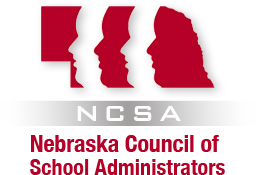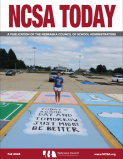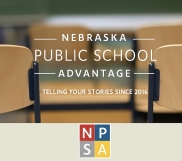A Matter of Life or Meth: Schools to play a role in Attorney General’s statewide efforts to put an end to methamphetamine use
By Tyler Dahlgren
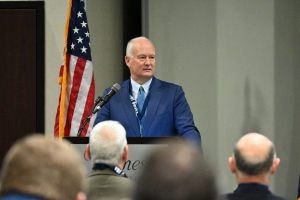
Constructed through collaboration between local and federal agencies, the coalition tasked with fighting meth is composed of the US Attorney’s Office, the Nebraska State Patrol, FBI of Omaha and the Drug Enforcement Administration (DEA) Omaha Division, in addition to the Attorney General’s Office. Federal authorities believe Nebraska’s model is the only of its kind.
Schools will play a prominent role in the “It’s a Matter of Life or Meth” campaign, particularly in prevention, one phase in a three-pronged structure that also includes treatment and law enforcement.
“When I think of our public schools, I think of a prevention and education program,” the Attorney General said. “The DEA has some educational tools for schools to implement. We want to build out tools for schools and other resources for communities to use in identifying and preventing the spread of meth, because we do see that access to this drug is becoming much greater.”
When meth surged onto the scene 20 years ago, the state combatted its subsequent wave of destruction by improving laws and focusing on shutting down home-based labs. That worked for a while, but then production shifted to sophisticated and significant-sized labs run by the drug cartels in Mexico, who were finding it harder to compete in the United States’ skyrocketing marijuana market.
“Meth is cheaper and stronger than it’s ever been before,” said Peterson. “Nebraska has more overdoses as a result of meth than opioids, which is unusual compared to other states. What activated our office were the conversations I was having with county attorneys. Counties across this state were seeing a spike in not only meth use, but also in the consequent criminal behavior associated with meth addiction.”
With an active producer pushing the drug across the border and into an active market, the situation required immediate action. While Peterson doesn’t think the campaign has fully arrived, he does feel the task force assembled is more of a giant leap than a first step when it comes to cutting off distribution channels.
“The next phase is prevention, and that’s why community involvement and particularly the participation and support from schools is important,” Peterson said. “Our goal is to raise meth abuse awareness in young people.”
Because meth is so cheap, it’s often the next step up from marijuana. While Peterson was surprised by the growing curve of users between the ages of 30 and 41, he was troubled by how the drug has trickled its way down to schools. Given the 293-percent increase in meth seizures by law enforcement from 2016 to 2021, that trend was likely inevitable but still extremely unsettling.
“You’re starting to see more high school kids who are willing to experiment with it,” he said. “It’s a very addictive drug. Unlike opioids and heroin, which are depressants, meth is a stimulant and very dangerous in that way.”
Meth saps the body of health, and it does so in a disturbingly quick and shocking fashion. The drug can’t hide its ugliness, and the “It’s a Matter of Life or Meth” campaign isn’t pulling punches. Addiction to meth is hell, and visual timelines of users can detail a steep and frightening depth of despair.
“Some cynics suggest that you can’t impact young people using the ‘Just Say No’ playbook, but when kids see the impact of some of these drugs, they do get impelled to say no,” said Peterson.
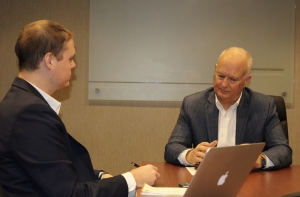 Peterson remembers his brother coming home from a day of school at Lincoln Southeast in 1969 and, after seeing side-by-side photographs of healthy lungs and the lungs of a 40-year smoker, pleading for his parents to kick the habit.
Peterson remembers his brother coming home from a day of school at Lincoln Southeast in 1969 and, after seeing side-by-side photographs of healthy lungs and the lungs of a 40-year smoker, pleading for his parents to kick the habit.
“He said ‘Mom and Dad, you have to quit smoking, because I saw pictures and it’s really, really scary,’” Peterson recalls. “That actually had an effect. The sad thing is there are kids in our schools going home to parents who are hooked on meth. There’s more of those kids than we could even imagine.”
Peterson sees much of the heavy lifting occurring in the treatment phase of his office’s innovative model. Arresting users, he said, won’t eliminate the problem. What they need is treatment, and, for meth addicts, that’s rarely a quick process.
“You have to have some degree of duration, and the courts have limited options for long-term treatment,” Peterson said. “That’s one of the biggest challenges we have right now. If those kids return (after receiving treatment) to the same community, the same crowd, it’s going to be very difficult for them to not revert back to using. With the school systems, the most helpful and effective way we can make a difference is through prevention efforts.”
The success of the Attorney General’s human trafficking and opioid prevention efforts lend themselves nicely to this current endeavor. The spirit of cooperation in Nebraska is strong, as is Peterson’s track record with like-minded campaigns. The Attorney General serves as treasurer on the Truth Initiative’s Board of Directors, and has seen that program’s effectiveness lower teen smoking from 23-percent to 5-percent through the utilization of multiple communication channels.
“We need to be strategic about reaching the younger age demographic where they are and exposing them to the dangers of meth,” Peterson said. “I want to be strategic about not just talking to them in an auditorium but going into where they are, on social media and other places, and saying ‘It’s your life. Think deeply about it.’”
Peterson knows from experience that his message will resonate. Make no mistake, he continued, students tend to listen. Nebraska’s students are very receptive.
“In seven years, I haven’t been in one school setting where the kids were out of control or weren’t engaged,” Peterson said. “They’re always respectful. That speaks well for schools. They always listen.”
Both the DEA and Nebraska State Patrol have agents/troops available to give presentations to students, administrators or parents in schools across Nebraska. To host a presentation in your district, contact either Emily Murray or Cody Thomas (information below).
To learn more, visit https://ago.nebraska.gov/life-or-meth.
Emily Murray
Public Information Officer
Drug Enforcement Administration (DEA) Omaha Division
Office: 571-387-3545
Cell: 402-214-0692
Cody Thomas – Public Relations Director
(402) 479-4985
cody.thomas@nebraska.gov
